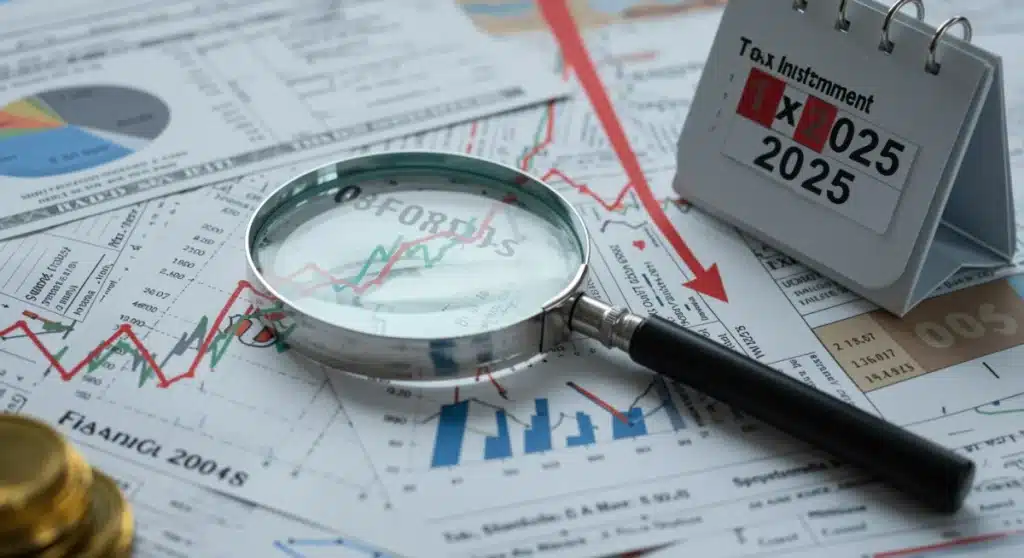2025 Tax Changes: Investment Impact Up to 15%

New 2025 tax policy changes are poised to reshape investment landscapes, potentially affecting returns by up to 15%, necessitating strategic financial planning for individuals and businesses.
As we approach 2025, the prospect of significant new 2025 tax policy changes looms large, with potential ramifications that could alter your investment returns by as much as 15%. Understanding these shifts is not merely an academic exercise; it’s a crucial step toward safeguarding and optimizing your financial future. This article will delve into the anticipated reforms, offering insights into how they might specifically affect various investment vehicles and what proactive measures you can take to adapt.
Understanding the Proposed 2025 Tax Reforms
The landscape of taxation is constantly evolving, and 2025 is shaping up to be a pivotal year for potential reforms. These changes are often driven by a mix of economic objectives, social priorities, and political dynamics, aiming to either stimulate growth, redistribute wealth, or address fiscal deficits. For investors, staying informed about these proposals is paramount, as even subtle adjustments to tax codes can have significant ripple effects across different asset classes and investment strategies.
While specific legislative details are still emerging and subject to political negotiation, several key areas are frequently discussed. These include potential adjustments to individual income tax rates, modifications to capital gains taxes, changes in corporate tax structures, and reforms impacting estate and gift taxes. Each of these areas carries distinct implications for how investment income is treated, how wealth is transferred, and ultimately, how attractive certain investment vehicles become. The political climate plays a vital role here, with different administrations often prioritizing varying aspects of fiscal policy. Investors must therefore monitor not only the legislative proposals but also the broader political discourse that shapes their eventual form.
Key Areas of Anticipated Change
- Individual Income Tax Rates: Potential changes to marginal tax brackets could affect after-tax returns from interest, dividends, and short-term capital gains.
- Capital Gains Taxes: Modifications to long-term capital gains rates or the introduction of new surtaxes could significantly alter the profitability of selling appreciated assets.
- Corporate Tax Structures: Adjustments to corporate tax rates or deductions might influence business profitability, indirectly affecting stock valuations and dividend payouts.
- Estate and Gift Taxes: Reforms in these areas could impact intergenerational wealth transfer strategies and the appeal of certain trusts or legacy planning tools.
The interplay of these potential changes creates a complex web of considerations for investors. For instance, a rise in capital gains taxes might push investors towards longer-term holdings or tax-advantaged accounts, while changes in corporate taxes could shift the attractiveness of domestic versus international equities. Understanding the nuances of these proposed reforms is the first step in formulating an effective investment strategy for the coming years. The goal is not just to react to changes, but to anticipate them and position your portfolio accordingly to mitigate adverse effects and capitalize on new opportunities. This proactive approach is essential for navigating the uncertain waters of future tax policy.
Impact on Individual Investors: What to Expect
For individual investors, the impending new 2025 tax policy changes could necessitate a thorough re-evaluation of their current investment strategies. The direct financial impact could range from minor adjustments to substantial shifts in after-tax returns, potentially influencing investment decisions across the board. Understanding how these changes might specifically affect different types of investments is crucial for proactive planning.
Consider, for example, changes to capital gains tax rates. An increase in these rates could reduce the net profit from selling appreciated assets, making strategies focused on frequent trading less appealing. Conversely, lower rates could incentivize more active management. Similarly, alterations to dividend tax rates could influence the attractiveness of dividend-paying stocks versus growth stocks. Investors holding a mix of assets will need to assess the cumulative effect of these changes on their overall portfolio’s tax efficiency. This involves not only looking at the top-line tax rates but also understanding any new deductions, credits, or exemptions that might be introduced or repealed. The goal is to maximize after-tax returns by strategically allocating assets and utilizing available tax-advantaged accounts.
Potential Shifts in Investment Behavior
- Long-Term vs. Short-Term Holdings: Higher short-term capital gains taxes might encourage investors to hold assets for longer periods to qualify for lower long-term rates.
- Tax-Advantaged Accounts: Increased utilization of IRAs, 401(k)s, and other tax-deferred or tax-exempt accounts could become even more critical for sheltering investment growth.
- Dividend vs. Growth Stocks: Changes in dividend tax treatment could shift preferences between income-generating and growth-oriented equities.
- Real Estate Investments: Adjustments to depreciation rules, capital gains on property sales, or mortgage interest deductions could impact real estate investment profitability.
Moreover, the proposed changes might influence decisions regarding asset location, i.e., determining which assets are held in taxable versus tax-advantaged accounts. For instance, high-growth investments or those generating significant short-term gains might be better suited for tax-deferred accounts. Conversely, investments with qualified dividends or municipal bonds, which offer tax advantages, might be more efficiently held in taxable accounts. The complexity of these decisions underscores the importance of personalized financial advice. Individual investors must consider their unique financial situation, risk tolerance, and long-term goals when adapting to the new tax environment. Ignoring these potential shifts could lead to suboptimal outcomes, highlighting the need for vigilance and strategic repositioning.
Corporate Tax Restructuring: Ripple Effects on Equities
Corporate tax restructuring, a significant component of the new 2025 tax policy changes, can send profound ripple effects throughout the equity markets. When corporate tax rates or deductions are altered, it directly impacts a company’s bottom line, subsequently influencing its profitability, investment decisions, and ultimately, its stock valuation. Investors must look beyond the headline numbers and understand the intricate ways these changes can reshape the corporate landscape and their portfolios.
A reduction in corporate tax rates, for instance, can lead to higher net earnings for companies, potentially boosting stock prices as investors anticipate greater profitability and shareholder returns. Conversely, an increase in corporate taxes could squeeze margins, leading to lower earnings and downward pressure on stock valuations. Beyond direct rate changes, modifications to specific deductions, credits, or international tax rules can also play a crucial role. For example, changes to research and development (R&D) credits might favor innovative sectors, while alterations to international tax frameworks could affect multinational corporations differently than purely domestic businesses. These nuances mean that not all companies or sectors will be impacted equally, creating both challenges and opportunities for discerning investors.
Sector-Specific Exposure and Corporate Strategies
Different sectors will likely experience varying degrees of impact from corporate tax reforms. Industries with high capital expenditures, significant international operations, or specific tax breaks could see their fortunes shift considerably. Here’s a breakdown of how corporate strategies might adapt:
- Technology Sector: Companies with substantial R&D investments might benefit from enhanced tax credits, encouraging further innovation.
- Manufacturing: Industries reliant on domestic production could see advantages from certain tax incentives, potentially leading to increased onshore investment.
- Multinational Corporations: Changes to international tax treaties or repatriation rules could significantly alter profit allocation and investment decisions for global giants.
- Small Businesses: Simplified tax codes or targeted deductions could provide a boost, fostering growth and job creation in local economies.

Furthermore, corporate tax changes can influence a company’s decision-making regarding capital allocation. Higher after-tax profits might encourage share buybacks, dividend increases, or greater investment in expansion and infrastructure. Conversely, a less favorable tax environment might lead companies to reduce spending, delay expansion plans, or seek tax-efficient mergers and acquisitions. Investors should pay close attention to corporate announcements and earnings calls for insights into how companies are adjusting their strategies in response to the new tax regime. Understanding these corporate responses is key to predicting which equities will thrive and which might face headwinds, enabling investors to make informed decisions about their equity holdings. The overall impact on the stock market will be a complex interplay of these individual corporate adjustments and broader economic sentiment.
Real Estate and Fixed Income: A New Tax Perspective
The realm of real estate and fixed income investments will not be immune to the new 2025 tax policy changes. These asset classes, often favored for their stability and income generation, could see their appeal and profitability altered by shifts in tax codes. For investors relying on these assets for portfolio diversification or steady returns, a careful re-evaluation of their tax implications is essential.
In real estate, potential changes could include modifications to property tax deductions, depreciation schedules, or capital gains treatment on property sales. For instance, limiting the deduction for state and local taxes (SALT) could disproportionately affect homeowners and real estate investors in high-tax states, potentially dampening property values or rental yields. Similarly, any adjustments to the 1031 exchange rules, which allow investors to defer capital gains taxes on real estate sales by reinvesting in similar properties, could significantly impact investment strategies for commercial and residential landlords. These changes could make certain real estate markets more or less attractive, prompting investors to reconsider their geographic and property type allocations. Understanding these potential shifts is critical for anyone with substantial real estate holdings, whether for personal use or investment purposes.
Fixed Income and Tax-Exempt Bonds
Fixed income investments, including bonds and other debt instruments, are also sensitive to tax policy. The primary concern here often revolves around the taxability of interest income. While municipal bonds typically offer tax-exempt interest at the federal level and sometimes at state and local levels, other bonds’ interest income is generally taxable. Any changes to individual income tax rates could directly affect the after-tax yield of taxable bonds, making tax-exempt alternatives more or less appealing.
- Municipal Bonds: Their tax-exempt status could become even more valuable if individual income tax rates rise, increasing their relative attractiveness compared to taxable bonds.
- Corporate Bonds: After-tax returns would be directly impacted by changes in ordinary income tax rates, potentially affecting their demand and pricing.
- Treasury Bonds: While federal tax applies, state and local taxes are usually exempt, a factor that could become more significant depending on state-specific tax reforms.
Furthermore, the broader economic environment influenced by tax changes can affect interest rates, which in turn impact bond prices. If tax policies stimulate economic growth and lead to higher inflation expectations, the Federal Reserve might raise interest rates, causing existing bond prices to fall. Conversely, policies that slow economic activity could lead to lower rates and higher bond prices. Investors in fixed income must therefore consider both the direct tax implications on their income streams and the indirect effects of tax policy on the broader interest rate environment. This dual perspective is crucial for maintaining a resilient and tax-efficient fixed income portfolio in the face of evolving tax regulations.
Strategic Financial Planning in a Changing Tax Landscape
Navigating the upcoming new 2025 tax policy changes requires a proactive and strategic approach to financial planning. Simply reacting to new legislation after it’s enacted may leave investors scrambling to adjust, potentially missing opportunities or incurring unnecessary tax liabilities. Instead, adopting a forward-looking strategy, ideally with professional guidance, can help mitigate risks and optimize returns.
One of the foundational elements of strategic planning is conducting a comprehensive review of your current financial situation. This includes assessing your income sources, existing investment portfolio, retirement savings, and any potential inheritance or estate planning needs. Understanding your current tax exposure and how it aligns with your long-term financial goals is the starting point. From there, you can begin to model the potential impact of various tax reform scenarios on your specific circumstances. This might involve stress-testing your portfolio against different capital gains rates, income tax brackets, or changes in deductions. The goal is to identify areas of vulnerability and opportunities for optimization before the changes take full effect.
Key Strategies for Adaptation
To effectively adapt to the evolving tax landscape, consider implementing several key strategies:
- Rebalance Portfolios: Adjust asset allocations to favor tax-efficient investments or those less exposed to potentially unfavorable tax changes.
- Utilize Tax-Advantaged Accounts: Maximize contributions to 401(k)s, IRAs, HSAs, and 529 plans to defer or eliminate taxes on growth and withdrawals.
- Tax-Loss Harvesting: Proactively sell investments at a loss to offset capital gains and potentially a limited amount of ordinary income.
- Review Estate Planning: Revisit wills, trusts, and gifting strategies in light of potential changes to estate and gift taxes to ensure efficient wealth transfer.
- Diversify Tax Exposure: Consider a mix of taxable, tax-deferred, and tax-exempt investments to create a more resilient portfolio against future tax fluctuations.

Furthermore, engaging with a qualified financial advisor or tax professional is invaluable during periods of significant tax reform. These experts can provide personalized advice, help interpret complex legislative language, and assist in implementing tax-efficient strategies tailored to your unique situation. They can also keep you updated on the latest developments, ensuring your plans remain agile and responsive to the final enacted policies. Strategic financial planning is not a one-time event but an ongoing process, especially in a dynamic environment like the one anticipated for 2025. By being proactive and seeking expert guidance, investors can transform potential challenges into opportunities for enhanced financial well-being.
Sector-Specific Opportunities and Risks
The impending new 2025 tax policy changes will undoubtedly create a mosaic of sector-specific opportunities and risks across the investment landscape. While some industries might flourish under new incentives or reduced tax burdens, others could face headwinds from increased costs or altered consumer behavior. Astute investors will need to conduct thorough due diligence to identify these nuanced impacts and position their portfolios accordingly.
For instance, sectors that are heavily reliant on research and development, such as biotechnology or software, might see a boost if R&D tax credits are expanded or made more generous. This could lead to increased innovation, higher profitability, and ultimately, greater investor interest. Conversely, industries with high capital expenditures, like manufacturing or infrastructure, could be significantly affected by changes to depreciation rules or investment tax credits. A reduction in these benefits could increase their effective tax rate, making new projects less attractive and potentially slowing growth. The key lies in understanding the specific tax provisions that apply to each sector and anticipating how companies within those sectors will adapt their strategies in response. This requires a deep dive into corporate financial statements and an understanding of industry-specific economic drivers.
Analyzing Industry Vulnerabilities and Advantages
Here’s a look at how various sectors might fare:
- Renewable Energy: Continued or expanded tax credits for clean energy projects could accelerate growth and investment in this sector.
- Healthcare: Potential changes to corporate tax deductions for employee benefits or pharmaceutical pricing could impact profitability across the healthcare value chain.
- Financial Services: Banks and investment firms could be affected by changes to capital gains tax rates, interest rate policies influenced by fiscal policy, and new regulatory frameworks.
- Consumer Staples: Generally more resilient, but changes to individual income taxes could affect consumer spending patterns, indirectly impacting sales.
- Technology (International Focus): Companies with significant international revenue streams might be sensitive to changes in global tax agreements or repatriation rules.
Moreover, the broader economic impact of tax policy changes can create secondary effects. If tax cuts stimulate consumer spending, consumer discretionary sectors might benefit. If they lead to increased government borrowing and higher interest rates, rate-sensitive sectors like utilities or real estate investment trusts (REITs) could face challenges. Investors should also consider the potential for legislative changes to create new market niches or accelerate existing trends. For example, tax incentives for domestic production could spur investment in certain manufacturing sub-sectors, while disincentives for carbon emissions could further drive demand for sustainable technologies. By carefully analyzing these sector-specific dynamics, investors can identify both the potential pitfalls to avoid and the promising avenues for growth that emerge from the evolving tax landscape.
The Role of Political Climate in Tax Legislation
The political climate plays an undeniably crucial role in shaping the final form and impact of the new 2025 tax policy changes. Tax legislation is rarely a purely economic exercise; it is deeply intertwined with political ideologies, electoral cycles, and the balance of power within government. Understanding these political dynamics is essential for investors trying to anticipate the direction and stability of tax reform.
Different political parties often hold distinct philosophies regarding taxation. One party might advocate for lower corporate and individual tax rates to stimulate economic growth and investment, while another might prioritize higher taxes on corporations and wealthy individuals to fund social programs or reduce income inequality. These ideological differences lead to vigorous debates and negotiations, making the legislative process complex and often unpredictable. The outcome of upcoming elections, shifts in congressional majorities, and even the public’s prevailing sentiment can significantly influence which tax proposals gain traction and ultimately become law. A divided government, for example, might lead to more moderate reforms or even gridlock, whereas a unified government could push through more sweeping changes. This political ebb and flow means that initial proposals can be heavily modified, or even abandoned, as they navigate the legislative journey.
Forecasting Legislative Outcomes
Forecasting legislative outcomes requires more than just tracking policy proposals; it demands an understanding of the political will and feasibility behind them. Key factors include:
- Electoral Cycles: Tax reform often becomes a central issue during election campaigns, with promises and proposals evolving based on voter sentiment.
- Congressional Majorities: The party in power in Congress significantly influences which bills are debated and passed.
- Presidential Priorities: The President’s agenda heavily shapes the direction and urgency of tax reform efforts.
- Public Opinion: Widespread public support or opposition can sway policymakers and impact the viability of certain tax changes.
- Lobbying Efforts: Various industry groups and special interests actively lobby to influence tax legislation in their favor.
Moreover, the political climate can affect the longevity and stability of tax policies. Reforms enacted by one administration or congressional majority can be reversed or significantly altered by a subsequent one, creating an environment of uncertainty for long-term financial planning. Investors must therefore remain agile and prepared to adapt their strategies as the political winds shift. This might involve diversifying internationally to mitigate domestic tax risks, or investing in sectors that are less sensitive to specific tax provisions. While predicting political outcomes is inherently challenging, staying informed about the political landscape and its potential implications for tax policy is a critical component of robust investment strategy. It allows investors to make more informed decisions, reducing exposure to political risk and positioning their portfolios for resilience in a dynamic regulatory environment.
| Key Point | Brief Description |
|---|---|
| Individual Investment Impact | Changes to capital gains and income tax rates could alter after-tax returns, affecting investment choices. |
| Corporate Tax Ripple Effects | Corporate tax rate adjustments will impact company profitability, stock valuations, and sector attractiveness. |
| Real Estate & Fixed Income | Modifications to property tax deductions, depreciation, and interest income taxability will influence these asset classes. |
| Strategic Planning Urgency | Proactive financial review, portfolio rebalancing, and professional advice are crucial for adapting to new tax policies. |
Frequently Asked Questions About 2025 Tax Changes
Changes to capital gains tax rates could reduce your net profit from selling appreciated assets. If long-term rates increase, it might incentivize holding investments for longer periods to defer realization or seek out tax-advantaged accounts to shelter growth more effectively.
Yes, corporate tax reforms can significantly impact your stock portfolio. Lower corporate taxes often boost company profits and stock valuations, while higher taxes can reduce earnings, potentially leading to lower stock prices. The impact varies by sector and company.
Start by reviewing your current investment portfolio and financial plan. Consider rebalancing, maximizing contributions to tax-advantaged accounts, and exploring tax-loss harvesting. Consulting with a financial advisor is highly recommended for personalized strategies.
Real estate investments could be impacted by changes to property tax deductions, depreciation schedules, or capital gains rules for property sales. These could influence profitability, rental yields, and the attractiveness of certain markets, requiring careful re-evaluation.
Yes, tax policies are dynamic and can change with future administrations or shifts in congressional power. They are often tied to economic conditions and political priorities, making ongoing monitoring and flexible financial planning essential for long-term success.
Conclusion
The impending new 2025 tax policy changes are poised to introduce a period of significant adjustment for investors across all asset classes. From individual income and capital gains taxes to corporate structures and real estate regulations, the potential for up to a 15% impact on investment returns underscores the critical need for proactive engagement and strategic financial planning. Rather than viewing these reforms as mere obstacles, savvy investors can leverage a deep understanding of the political and economic landscape to identify new opportunities and fortify their portfolios against potential risks. Staying informed, seeking expert guidance, and maintaining a flexible investment approach will be paramount to navigating this evolving tax environment successfully and optimizing your financial future.





